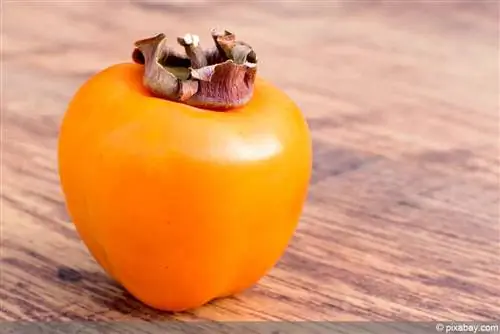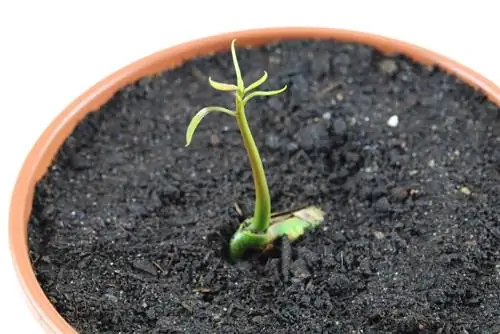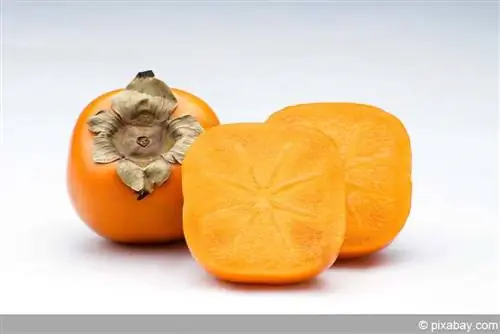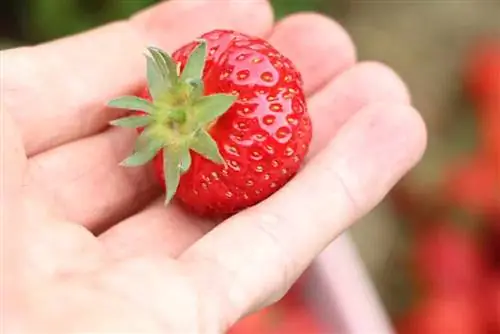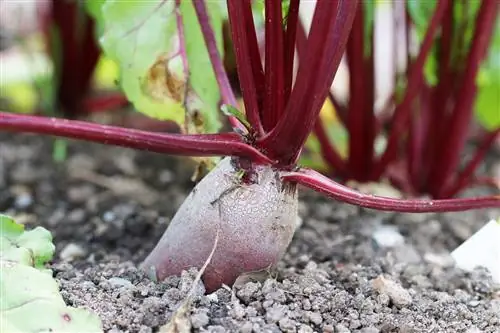- Author admin [email protected].
- Public 2023-12-17 03:39.
- Last modified 2025-01-24 12:45.
It doesn't always have to be an apple tree. Other trees also bear delicious fruit. How about a persimmon tree? This exotic plant with delicate yellow flowers and orange fruits comes from far away Asia and is increasingly making itself at home here. Mostly in a pot, but now and then it also takes over the garden. This is how you become a good host for him.
Origin and appearance
The ebony family is the family of khaki (botanically Diospyros kaki). This tree, which comes from Asia and can grow up to 10 meters high, is surprisingly similar in appearance to our native apple tree. Its orange fruit, on the other hand, is confusingly similar to the tomato. It is also known to us as Sharon Fruit. Of course, it impresses with its own taste, which is not “tomatoey” at all.
This delicious fruit has contributed to the fact that this tree is now grown not only in Asia. It is planted everywhere on earth where the climatic conditions are met. Even here, where the climate is rather hostile, the temptation is to pull the seeds out of the fruit and stick them in the ground. It is also available to buy as a finished plant.
Varieties
The persimmon tree is also available for purchase under the names persimmon, persimmon and Sharon fruit. It comes in different varieties. The particularly robust varieties are ideal for cultivation in continental climates. The following varieties also have a good taste:
- 'American Kaki Meader' is particularly hardy
- ‘Cioccolation’ delivers small and sweet fruits
- ‘Tipo’ brings abundant harvest
- ‘Vainiglie’ exudes a fine vanilla scent
- ‘Sajo’ is the variant for gourmets
Seed propagation
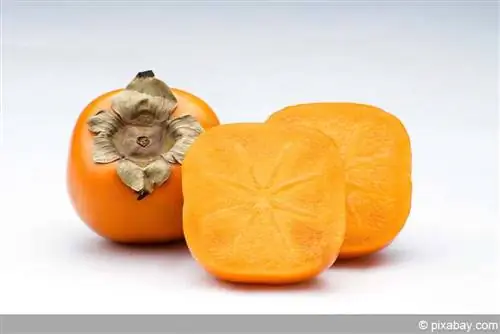
If you find seeds in a ripe Sharon fruit, which is rare, and want to grow a persimmon tree from them, then it's best to get started immediately. The fresher the seed is, the better. You can of course also purchase seeds, but here too the seeds should not wait long to germinate. How to prepare for germination:
- Scratch off the slimy layer with a kitchen towel.
- Clean the fresh core under water.
- Dry the seeds for a few days.
- Place the dried seeds in a foil bag.
- Add a handful of wet sand.
- Put the sealed bag in the refrigerator for three months.
After three months, the germination inhibition is lifted and the seeds can be sown.
- Fill a flower pot with potting soil.
- Place the seeds on top and cover them with 1 cm of soil.
- Wet the substrate well.
- Then cover the pot with plastic wrap.
- Place the pot in a bright place that is at least 20 degrees warm.
- After about 4-6 weeks, the seeds germinate and the first leaves grow.
- Repot the small plants in individual pots.
- Repot once the old pot has become too small.
Buying a tree
Instead of hoping for seed propagation, you can also buy a small persimmon tree. Only purchase a self-pollinating persimmon tree if future crop yield is an important criterion for you. The tree should appear he althy and have beautiful growth. Also keep in mind that you have to get used to the winter as a container plant for several years before you can plant it outside.
Location
Sweet fruits need plenty of sun to develop their optimum aroma. The warmest place in the garden should be reserved for this tree. A nearby wall can release the stored solar heat to it at night. Also think about the future and plan plenty of space when planting the tree. It doesn't take long and the little tree has grown into a stately tree.
A distance of around four meters from other trees or the house should be maintained. Do not hide the persimmon tree in a secluded corner of the garden. Give him a stage on which he can show off his colorful foliage display in autumn. Persimmons in the pot also need a bright, warm and wind-protected location.
Planting soil
Use well-drained soil for the container planting and mix in some sand and humus. In the garden, slightly loamy soil is preferable as it can store water well.
Repotting
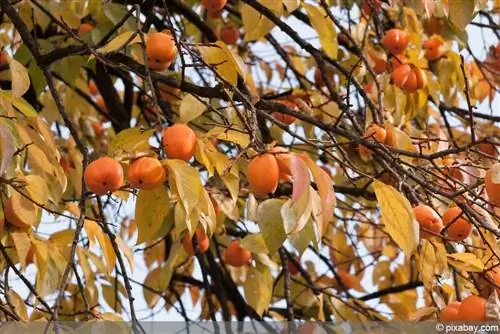
Kakis that grow in containers need to be repotted regularly in spring.
- Bucket must have several drainage holes
- new bucket should be significantly larger than the old one (about twice)
- Bucket must be sufficiently stable according to the size of the plant
- at the bottom there is a drainage layer several centimeters high
- A mixture of garden soil and sand is suitable as a substrate
- watering is necessary after repotting
Planting persimmons
A persimmon tree that is several years old can be planted directly in the garden, even if it is only partially hardy.
- Dig a planting hole that is twice as wide as the root ball.
- Mix the excavated material with humus and sand.
- Place the persimmon in the hole, as deep as it was previously in the container.
- Fill the planting hole, pressing the soil firmly.
- Water the persimmon tree well.
Tip:
Give the young tree a firm hold with a suitable support rod. Held like this, it just grows upwards.
Pouring
The persimmon tree needs a lot of water. However, if the persimmon tree has already grown well in the garden, it no longer needs to be watered. Provided that the summer is average and precipitation falls regularly. You won't be spared the garden hose or watering can if:
- the persimmon tree freshly planted or
- the persimmon tree grows in a pot or
- the summer stays dry for a long time.
Pot soil should never dry out completely in summer. In winter, when the leaves have fallen from the branches, neither the persimmon in the garden nor the persimmon in the pot needs much water. Watering is greatly reduced for potted plants and stopped completely in the garden.
Fertilize
A persimmon tree that grows in good soil in the garden does not need fertilizer. However, persimmon trees in pots do. A complete fertilizer and a special fertilizer for fruit trees are possible. It should be low in nitrogen and used sparingly. Once a month is enough, in summer this can be increased to twice a week. When repotting, additional organic fertilizer can be added to the plant soil. Too much fertilizer can lead to excessive growth, which is less suitable for keeping in containers due to space constraints.
Educational Cut
Like local fruit trees, the persimmon should be pruned so that the crown develops nicely. The foundation for a good crown structure is laid at a young age. And a good crown is synonymous with a good harvest.
- Choose a time in spring or autumn.
- Only use sharp and clean tools for cutting.
- Leave the strongest and longest shoot uncut.
- Shrink selected secondary shoots a little.
Tip:
Crowns that are too dense can easily be thinned out in autumn.
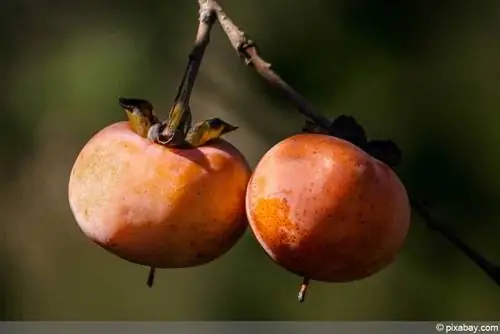
Which secondary shoots need to be shortened or removed entirely depend on the desired growth habit. The following variants are available:
- High trunk
- Half trunk
- Shrub
- Espalier tree
pruning
In early winter, before a persimmon tree planted in a container moves to winter quarters, it can be cut back. If the pruning was not done before winter quarters, the persimmon tree can alternatively be cut in spring. Use sharp and clean secateurs to cut back shoots that have grown too long to about 2/3.
Harvest
The persimmon tree blooms in spring and the Sharon fruits are ready to harvest from around September. By then the persimmon tree has long since shed its leaves. It looks a bit unusual, but is absolutely normal for this exotic tree.
- Harvest time: September to November
- Ripe persimmons have a strong orange color
- harvest before the first frost
- Allow persimmons to ripen (room with 0-2 degrees and high humidity)
- Use quickly as it doesn’t last long
Diseases
Give your persimmon tree the right care and it will be bursting with he alth. This exotic plant is extremely resistant to disease. If the plant somehow weakens and does not develop as desired, the location and care should be examined. Vary things a bit and see how the plant gets it.
Pests
Pests give persimmons a wide berth, much to the gardener's delight. Every now and then a few animals get lost, but they usually don't pose too much of a threat. Whenever the persimmon is outdoors, it is close to the aphids' home. The tree can handle this well. Only act if it is clear that they are causing major damage to the persimmon tree.
Kaki plants that grow in containers are occasionally visited by scale insects and spider mites. The usual pests that always appear when care is not quite right or the site conditions or temperatures are not optimal. Don't place your potted plants too close together to prevent pests from wandering around. Keep an eye out for these unwanted guests on a regular basis and take appropriate, natural and environmentally friendly measures as soon as possible. This is also gentler on your persimmon tree than the big “poison club”.
Overwintering potted plants
In winter, the persimmon tree sheds its leaves and begins its annual rest period. He may have been happy outdoors in the summer, but what about the winter hardiness now? When it comes to winter hardiness in general, there is never a simple yes or no answer. Given the enormous number of different plant varieties, there are many fine intermediate stages. On the other hand, winter hardiness is not absolute; it can depend on the age and he alth of the plant. Appropriate protective measures can also support winter hardiness.
The Asian persimmon is a plant that is only partially hardy. Their survival is at stake as a harsh winter approaches. Only after about four years should persimmon plants be strong enough to spend the winter outdoors, even if they grow in pots.
- Location directly against a wall because it gives off some heat
- sheltered place
- Styrofoam under the pot insulates ground frost
- Wrap trunk with coconut or jute mats
Note:
Cushion film insulates the cold well, but also reliably prevents air circulation. Keep your hands off it.
Overwintering young plants
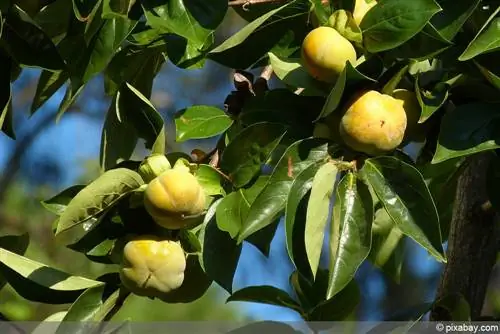
Young plants are not yet strong enough to withstand the cold. Any plant that has not yet reached its fourth year of life is considered young. Of course, what matters is how well she really developed in these first few years. If you are unsure whether it can withstand the cold, then it is better to wait another year. When overwintering young plants the following applies:
- the pot has to be put in as soon as there is a risk of night frost
- dark winter quarters such as basements or garages are optimal
- Room temperature should be around 5 degrees
- Bright accommodation is possible, but it has to be cold
- in spring, when it gets milder, the pot can be taken out again
- If there is an unexpected cold snap, the plant has to go back in temporarily
Winter protection in the garden
In areas with milder winters, the persimmon tree can grow directly in the garden. The older the tree is, the more cold winters it has survived outdoors as a potted plant, the better equipped it is to withstand the cold. Nevertheless, take further protective measures in winter:
- Cover the ground with bark mulch in autumn.
- Put a second layer of softwood brushwood on top.
- Protect branches and trunk with natural materials such as coconut or jute.
Even the strongest tree and the best winter protection are no guarantee that a persimmon tree will survive safely. The winter weather in Northern Europe is too unpredictable and occasionally Siberian cold.

